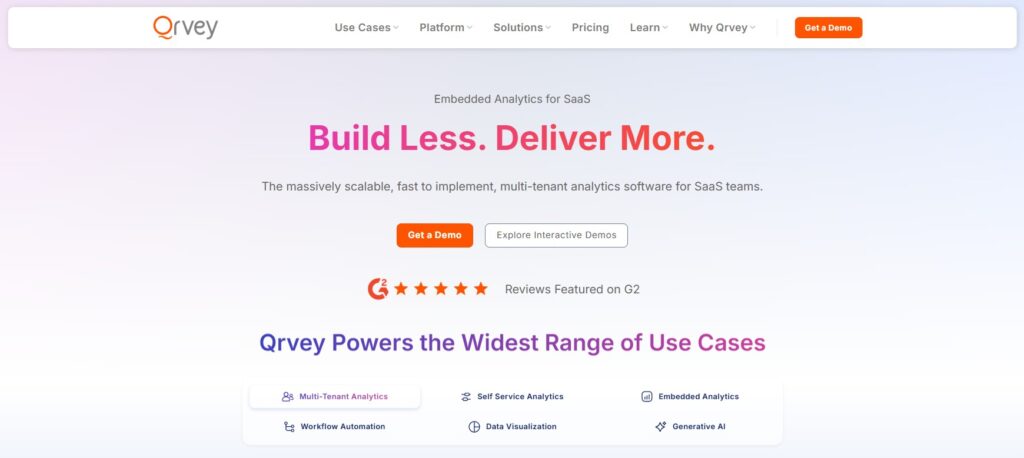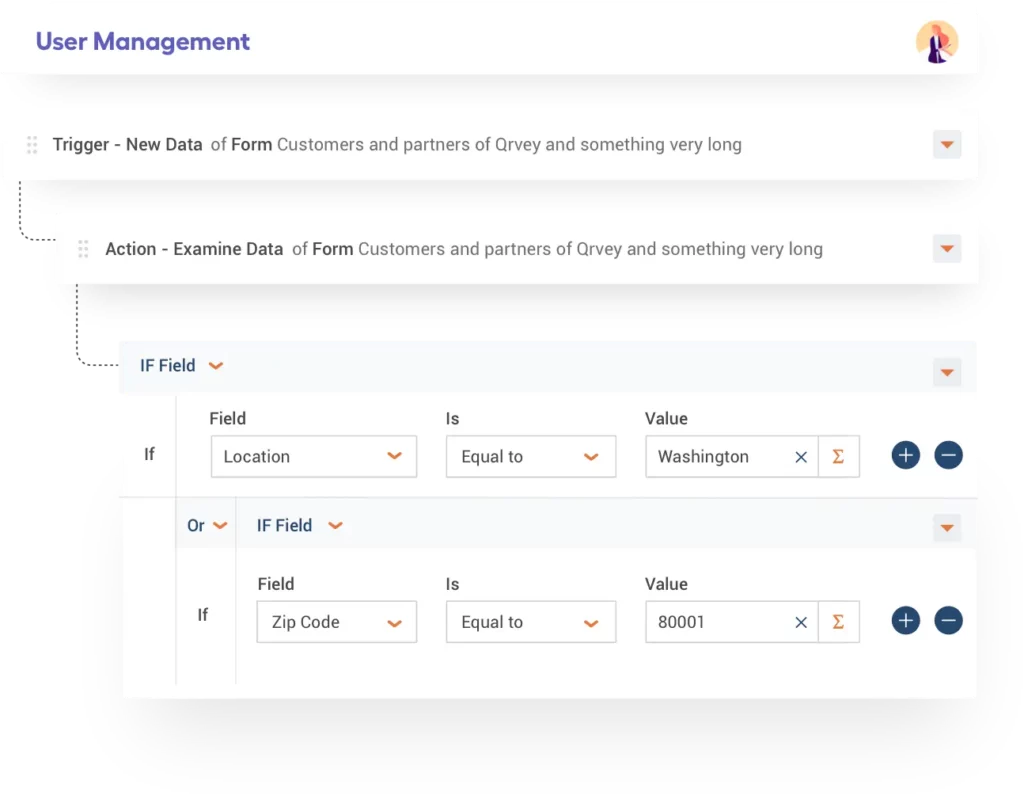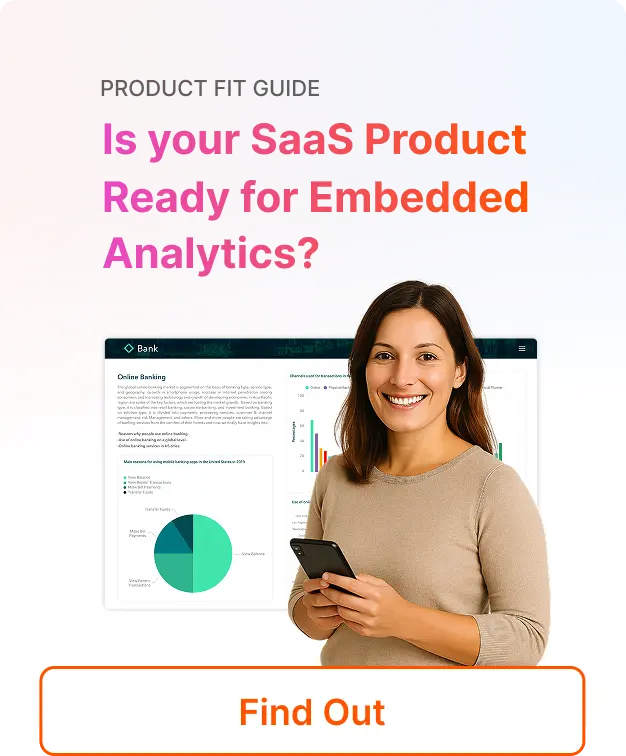
⚡Key Takeaways
- Snowflake offers robust capabilities, but its pricing may be complex. Between cloud provider, region, compute costs, and data storage, Snowflake’s usage-based pricing can be difficult to predict—especially for teams without a dedicated data ops function.
- Hidden costs can sneak up fast. Compute is billed per second, storage includes hidden layers, and cross-region data transfer isn’t free. Without careful monitoring, these extras can quickly increase your bill.
- Qrvey offers a simpler alternative for SaaS teams. For SaaS companies that need embedded analytics without the overhead, Qrvey provides a no-code, all-in-one platform with predictable pricing and less technical complexity.
Snowflake is a powerful platform—but figuring out what you’ll actually pay for it? That’s not always so clear. In fact, many businesses struggle with Snowflake costs.
All in all, Snowflake doesn’t have a flat rate or fixed monthly cost. Instead, it follows a pay-as-you-go model based on actual usage.
It comes down to three main factors: your cloud services, region, and account type.
And that’s not all—it also varies depending on compute usage, data storage, and data transfer.
So, how does Snowflake pricing translate to actual billing? This guide breaks down how Snowflake pricing really works—what’s included and what hidden costs to watch out for.
How Much Does Snowflake Cost?
Before we dive into the many ways Snowflake’s pricing can vary, let’s start by looking at its standard pricing table with its distinct editions (plans).
This applies to most American regions and for the three available cloud providers (AWS, Azure, and Google Cloud Platform).
| Pricing table for US East (Northern Virginia) on AWS | ||||
| Edition | Standard | Enterprise | Business Critical | Virtual Private Snowflake |
| Description | Introductory offering with access to core platform functionality. | Best for companies with large-scale data initiatives looking for more control. | Offers specialized functionality for highly regulated industries. | Provides a completely separate Snowflake environment |
| Features | ✓ All core platform features. ✓ Fully managed elastic compute ✓ Encryption ✓ Data sharing ✓ Optimized storage. | ✓ All Standard features ✓ Multi-cluster compute ✓ Granular governance and privacy controls ✓Extended Time Travel windows. | ✓ All Enterprise features ✓ Tri-secret Secure ✓ Access to private connectivity ✓ Failover and failback for backup and disaster recovery. | ✓ All Business Critical features✓ Separate environment, isolated from all other Snowflake accounts. |
| Starting credit price | $2.00/ per credit ($USD) | $3.00/ per credit ($USD) | $4.00/ per credit ($USD) | Custom price |
| On-demand storage | $23.00 ($USD)per TB per month | |||
Qrvey: An Alternative

Feeling a little lost with Snowflake’s pricing? You’re not alone.
The good news? There are simpler alternatives that are easier to understand and budget for.
For example, Qrvey is designed specifically for SaaS companies, taking the headache out of billing with a straightforward, custom pricing model.
No tracking credits, no surprise unexpected fees—just a clear plan based on your analytics needs.
Even better? Qrvey is an all-in-one platform. It handles everything from data collection and transformation to dashboards, automation, and embedded analytics.
This way, you don’t need to juggle multiple tools or worry about hidden costs creeping in.
Snowflake Pricing Plans: A Breakdown
Snowflake’s pricing can vary based on a few key factors that affect how much you’ll pay per credit. Here’s the typical credit cost range for each Snowflake edition:
| Edition | Starter | Enterprise | Business Critical | Virtual Private Snowflake |
| Credit cost range | $2.00 – $3.10 | $3.00 – $4.65 | $4.00 – $6.20 | $6.00 – $9.30 |
To get a clearer idea of what you’d pay, you can use a Snowflake pricing calculator. In the meantime, let’s break down the key factors that impact your cost per credit so you can better estimate your potential spend—or savings.
Cloud Services Layer
Snowflake runs on AWS, Azure, and Google Cloud—and the provider you choose directly affects your pricing.
While Snowflake abstracts much of the cloud complexity away, it still passes on the infrastructure costs associated with each platform.
That means compute, storage, and transfer rates can differ slightly depending on whether you’re hosted on AWS, GCP, or Azure.
Regional Rates
Location matters more than you think. Snowflake’s pricing varies by region, which means the same workload could cost more in the EU than in the US.
This is due to a mix of factors, such as data laws, local infrastructure costs, and cloud services pricing per region.
For example, storing and querying data in Frankfurt or London generally costs more than doing so in Oregon or Virginia. Let’s see both examples:
| AWS Pricing Table – US East (Oregon) Region | ||||
| Edition | Starter | Enterprise | Business Critical | Virtual Private Snowflake |
| Credit cost | $2.00 | $3.00 | $4.00 | Custom |
| On-demand storage | $23.00per TB per month | |||
| AWS Pricing Table – London Region | ||||
| Edition | Starter | Enterprise | Business Critical | Virtual Private Snowflake |
| Credit cost | $2.70 | $4.00 | $5.40 | Custom |
| On-demand storage | $24.00per TB per month | |||
These regional price differences apply to compute, storage, and even data transfer—especially if you’re moving data between regions or across clouds.
So, if you’re running global operations or serving customers in multiple areas, regional planning is key to optimizing costs.
Type of Account (Pre-Purchased Capacity vs. On-Demand)
Snowflake offers two main pricing models: On-demand and Capacity. Choosing between the two comes down to your usage patterns.
- On-demand accounts are billed at a fixed rate per credit with no upfront commitment. This is ideal for flexibility, experimentation, or early-stage projects—but it’s also the most expensive option per credit.
- Pre-purchased capacity accounts involve purchasing Snowflake credits upfront, typically on an annual basis. In return, you get discounted rates and more predictable budgeting.
How to choose the right one?
- If your team runs regular workloads and wants to optimize costs, capacity is the smarter route.
- If you’re scaling up or still exploring how Snowflake fits into your stack, on-demand offers more agility.
Snowflake Hidden Costs
On top of the previous factors, other Snowflake costs can sneak up on you. Let’s take a look at them.
Compute Cost
Snowflake offers elastic scaling, which means you can automatically adjust compute resources based on demand.
Compute cost refers to the amount you pay to process and analyze your data—based on how much compute power you use and for how long.
In Snowflake, this happens through something called a virtual warehouse. This is basically a set of compute resources that run your queries, load your data, or refresh your reports.
Snowflake offers warehouse sizes ranging from X-Small to 6X-Large, with each level doubling in both compute power and fees. To put it simply—a larger warehouse increases compute cost.
So what does that mean for your bill? Whenever a warehouse is running, it’s using Snowflake credits, which translates into real dollars.
In short—compute usage equals credit usage, which equals higher fees.
But here’s the catch—virtual warehouses are billed by the second. This means that costs spike when they’re oversized, left running, or not fully used. Auto-suspend settings help, but they’re not always optimized by default.
| VIRTUAL WAREHOUSE CREDITS PER HOUR | ||
| Virtual warehouse size | Compute credit per hour | Snowpark* optimized compute credits per hour |
| XS | 1 | N/A |
| S | 2 | N/A |
| M | 4 | 6 |
| L | 8 | 12 |
| XL | 16 | 24 |
| 2XL | 32 | 48 |
| 3XL | 64 | 96 |
| 4XL | 128 | 192 |
| 5XL | 256 | 384 |
| 6XL | 512 | 768 |
*Snowpark-optimized warehouses are a warehouse type that offer 16 times more memory than standard warehouses at the same size—though they come at a 50% higher cost.
Data Storage Cost
Storage costs can also add up. Snowflake charges a flat dollar rate for storage, not credits, depending on your cloud services provider and region.
For example, on-demand pricing for customers in AWS (Amazon Web Services) in U.S. regions is around $23.00 per terabyte per month.
| AWS Pricing Table – US East (Oregon) Region | ||||
| On-demand storage | $23.00per TB per month | |||
Storage in non-U.S. regions tends to be more expensive—customers using AWS in Zurich (Switzerland) pay $26.95.
| AWS Pricing Table – Zurich (Switzerland) Region | ||||
| On-demand storage | $26.95per TB per month | |||
What catches many teams off guard is that you’re not just paying for the data you see. Features like Time Travel automatically retain extra versions of your data, which silently increase your storage usage over time.
Data Transfer Fees
Data transfers within the same cloud region are usually free, but moving data across regions or between cloud providers can lead to extra charges. These are often referred to as ingress or egress charges.
This includes things like replicating databases, unloading to cloud storage, or cross-region data sharing.
If you’re running in a multi-cloud or global setup, keep an eye on how your data moves—those small transfers can add up fast.
Snowflake Pros & Cons

Snowflake’s pricing can be a bit tricky to navigate—but what do you get in return? And where does it fall short? Let’s take a look at the pros and cons.
Pros
- Scalable database performance: Easily handles massive data volumes with automatic scaling.
- Separation of storage and compute: Lets you optimize performance and cost independently.
- Cross-cloud flexibility: Works on AWS, Azure, and GCP, making it cloud-agnostic.
- Strong data sharing: Seamlessly shares data across accounts and regions.
- Broad language support: SQL, Python (via Snowpark), and more.
- Advanced analytics capabilities: Snowflake supports complex queries, machine learning integrations, and large-scale data processing.
Cons
- Complex pricing: Usage-based billing can be hard to predict or control.
- No data visualization capabilities: You’ll need a separate tool for visualizations and dashboards.
- Data transfer costs: Cross-region/cloud data movement isn’t free and adds up fast.
- Learning curve: Features like Snowpark or resource monitors require technical expertise.
- Costs from inactive warehouses: Virtual warehouses can silently burn credits if not managed.
Who Is Snowflake Best For?
Snowflake is built for scale, speed, and flexibility—but it’s not one-size-fits-all. It shines in environments with complex data needs and dedicated teams.
Below are three ideal user profiles who get the most out of what Snowflake offers.
Data Engineers at Large Enterprises
Snowflake is a great fit for large enterprises with complex data pipelines. Data engineers benefit from its ability to scale compute and storage independently, automate workloads, and support multi-cloud environments.
Analytics Teams with Big Data Needs
For analytics teams working with massive datasets, Snowflake offers high performance, fast querying, and powerful data sharing.
Its SQL-native environment and support for popular BI tools make it easy to connect, explore, and visualize data—especially when speed and simultaneous processing are key.
SaaS Companies with a Data Product
SaaS businesses embedding data or offering analytics to customers can leverage Snowflake’s scalability and security.
That said, Snowflake might not be the most affordable fit for SaaS companies.
Since compute is billed by the second and credits are consumed hourly, costs can skyrocket when your app needs to deliver instant availability to every user.
And because SaaS providers are typically focused on driving usage, that constant demand can make Snowflake’s pricing tough to manage at scale.
Snowflake Customer Reviews
Positives
“One of the best data warehousing tools for your ETL needs!” – Ajinkya J., verified G2 review.
“A powerful and scalable cloud data warehouse tool!” – Balaji R., verified G2 review.
Complaints
“Costly if data is too big – You can’t own the data, you have to depend on the Data Engineering team” – Tanika S, verified Capterra review
“Bad UI, unintuitive, can’t process info quickly, wish I could do more with the data for analyst use-cases” – Verified G2 review
Alternative To Snowflake: Qrvey
Does Snowflake feel like more than you need? Or is its pricing model too complex?
Qrvey is a strong alternative for teams building SaaS products with embedded analytics.
Unlike Snowflake, which focuses on raw data infrastructure, Qrvey is an all-in-one analytics platform designed specifically for SaaS teams.
It offers simpler, predictable pricing. Plus, it includes everything from data ingestion to dashboards in a single stack.
Here are two standout features that set Qrvey apart:

Self-service embedded analytics for SaaS:
You can easily embed dashboards and reports into your app, support multi-tenancy, and customize analytics per customer—without a heavy lift from your engineering team.

No-Code automation for data workflows:
Qrvey makes it easy for teams to automate their data workflows without writing code or relying heavily on developers.
Does Snowflake Pricing Fit Your Budget?
Snowflake’s pricing is flexible and scalable. That said, its usage-based pricing model can be tough to predict—and even tougher to control without a dedicated data team.
Looking for a more straightforward, scalable solution for embedded analytics?
Qrvey might be a better fit. Specially built for SaaS teams, it offers clear, custom pricing without the complexity.
Discover how Qrvey can transform your embedded capabilities. Book a demo and see it in action.

Natan brings over 20 years of experience helping product teams deliver high-performing embedded analytics experiences to their customers. Prior to Qrvey, he led the Client Technical Services and Support organizations at Logi Analytics, where he guided companies through complex analytics integrations. Today, Natan partners closely with Qrvey customers to evolve their analytics roadmaps, identifying enhancements that unlock new value and drive revenue growth.
Popular Posts
Why is Multi-Tenant Analytics So Hard?
BLOG
Creating performant, secure, and scalable multi-tenant analytics requires overcoming steep engineering challenges that stretch the limits of...
How We Define Embedded Analytics
BLOG
Embedded analytics comes in many forms, but at Qrvey we focus exclusively on embedded analytics for SaaS applications. Discover the differences here...
White Labeling Your Analytics for Success
BLOG
When using third party analytics software you want it to blend in seamlessly to your application. Learn more on how and why this is important for user experience.








